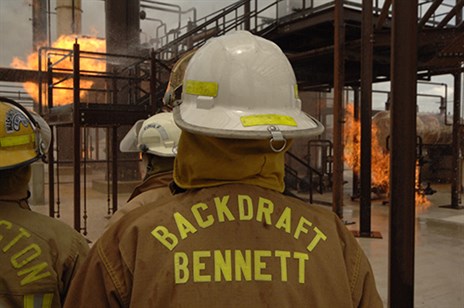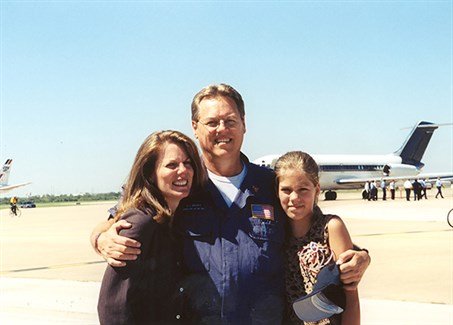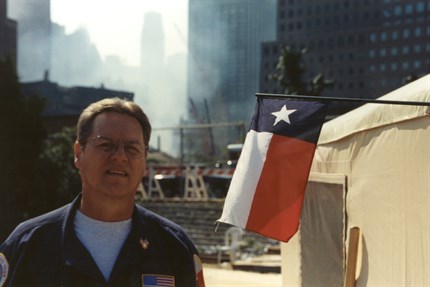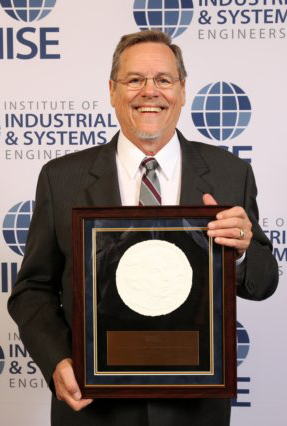Entrepreneur, researcher, professor, software designer, federal task force director, vice chancellor and dean, all titles held by Dr. G. Kemble Bennett during his unusual, yet rewarding career.
Over the course of his career, Bennett was active in the Institute of Industrial Engineers, now the Institute of Industrial and Systems Engineers (IISE). In May, he was honored with the Frank and Lillian Gilbreth Industrial Engineering award, the highest and most revered honor given by IISE. The award recognizes the contributions recipients have made in the field and to the welfare of mankind.

“I was both honored and humbled to receive this award,” Bennett said. “To be listed among those who have achieved this award is just unbelievable.”
Bennett is the vice chancellor and dean emeritus of the Texas A&M University College of Engineering and a senior professor in the Department of Industrial and Systems Engineering.
From creating efficient work systems to assisting with the first lunar landing to serving on numerous public safety and health taskforces, Bennett has led a life of service to education and the public.
A successful foundation
“I honestly did not have a dream job,” Bennett said. “I went into the military right out of high school and then I went to Florida State University to study mathematics.”
Upon graduation, Bennett was offered an engineering position with the Martin Company in his hometown of Orlando, Florida. Bennett soon decided to pursue higher education, moved across the country to California and began working for the Lockheed Missiles and Space Division.
“When I was about halfway through my master’s degree, they placed me in the research labs for Lockheed.” Bennett said. “This was pretty exciting because just about everyone in the lab had their Ph.D. except for me and a few others. I would look at my paycheck and I would look at their paycheck and think, well, maybe I need to get even more education.”
After some persuasion from a colleague at Lockheed, Bennett moved to Lubbock, Texas, and began running a computing center at Texas Tech University while earning his Ph.D.
While writing his doctoral dissertation, Bennett worked in Houston at the NASA Manned Spacecraft Center, now known as the Johnson Space Center.
“We were there to provide advice to the engineering group if they needed other eyes to review computations or some high level modeling,” Bennett said. “It was like being in an internal consultant group.”
While at NASA, Bennett had the opportunity to work on software that was implemented during the first lunar landing.
“That was really exciting for me and I was definitely hooked at that point,” Bennett said.
Prior to finishing his Ph.D., Bennett was offered a job at Virginia Polytechnic Institute (VPI) by Dr. Paul Torgersen, the department head of the Department of Industrial Engineering and Operations Research.
Hooked on continuing his involvement in academics and research, Bennett took the position at VPI, where he stayed for four years before moving back to Florida.
“I became a faculty member in the industrial and management systems engineering department at the University of South Florida and eventually became the department head,” he said.
In his “spare” time
In addition to actively teaching and conducting research, Bennett and two other professors combined their expertise to develop a hardware and computer system to automatically record the results of blood tests.
“Back then, they had to hand-record the results,” Bennett explained. “There are a lot of places to have errors with people manually recording numbers. We developed a way to record the data electronically.”
Bennett and his colleagues, a computer scientist and an electrical engineer, ran the small company out of the bedroom of an apartment.
“We formed this company because several hospitals and laboratories were interested in our solution,” he said. “It was one of those situations where a company said, ‘If you can do that, can you do this for us?’ So, we would add to our software and hardware package. The next thing you knew, we were buying big computers ourselves, tying in our hardware, putting all of our software packages on them. We had to get it all done in 30 days so they could pay us, and we could pay off the bank.”
Soon, Smith-Kline, a large pharmaceutical company, asked Bennett’s team to implement its programs in 77 different offices around the United States. This request would require the trio to open offices in each city, quit their day jobs and commit to the business full-time.
“We were not ready to become full-time businessmen, nor were we willing to leave education,” Bennett said. “So, we sold them the company and they got a good deal.”
Aggies are calling

A few years later, Bennett was asked to apply for the department head position in industrial and systems engineering at Texas A&M. While he was reluctant at first, Aggieland won his heart.
“I came to College Station and really liked what I saw,” Bennett said. “The potential in the department was clear and there was a very strong faculty needing leadership.”
With the blessing of his wife, Bennett accepted the position and began his career in administration at Texas A&M in 1986.
“At my first job, Paul Torgersen told me that academically, I could touch more lives through management than I could in the classroom,” Bennett said. “He said it would not be as visible, but it would have greater impact. As department head, I found this to be true.”
A fire ignites
Known as an outstanding researcher, Bennett quickly became the associate dean for research and oversaw three state agencies: the Texas A&M Engineering Experiment Station (TEES), the Texas A&M Transportation Institute (TTI) and the Texas A&M Engineering Extension Service (TEEX). Impressed with his work, the Texas A&M Board of Regents then appointed him the director of TEEX.
“I went to TEEX in 93 and found the world’s best people,” he said. “They were so dedicated to their job-skill training mission, serving the state and helping people get jobs. It was infectious.”
During his early time at TEEX, Bennett saw a need for more work in emergency response.
“The state emergency management plan gave TEEX the responsibility to respond to and coordinate urban search and rescue disasters for the state,” Bennett said. “As the director, I had to be sure we were prepared to respond when called upon.”
The biggest wake-up call for Bennett came with the Oklahoma City bombing in 1995.
“I realized that I was responsible for getting people to respond if something like that occurred in Texas, but I didn’t know what to do,” he explained.
Bennett recognized the need for a state urban search and rescue team and began talking with other leaders in the field to create such a team.
With the closest Federal Emergency Management Agency (FEMA) team a few states away in Tennessee, Bennett immediately realized two goals for his developing group.
“I knew, number one, we had to be a state team,” Bennett said. “And number two, I wanted to become a federal team.”
Using blueprints mandated by the State of Texas and federal guidelines, Texas Task Force 1 was established to provide trained recovery and medical assistance in response to natural and man-made disasters in the state and around the country.
Bennett also developed the idea of Disaster City, a 60-acre training facility that simulates various disasters. This facility has become a premiere destination for emergency and disaster training for rescuers from around the world.
Bennett pressed on to achieve his second goal of the task force, becoming a federal team. He met with U.S. Sens. Kay Bailey Hutchison and John Cornyn to support his efforts.
“They joined me and agreed that we should have a national team here,” Bennett said. “FEMA finally came down and certified us. Today, we are one of the most experienced and elite teams in the federal system. They had never seen an operation like ours.”
An inevitable threat
In his efforts to establish Texas Task Force 1, Bennett made numerous contacts with leaders and government officials who were working to prevent a terrorist attack on U.S. soil. Bennett and the group of forward thinkers began looking for opportunities and facilities to train personnel in biochemical counterterrorism, fire and explosive response efforts in case there was an attack.
 “We formed the National Preparedness Consortium and I became the chairman,” Bennett said. “We developed curriculum and training materials that were transferred to the states. It was amazing how quickly the curriculum was adopted and communities recognized their need for specialized equipment. Seeing the level of preparedness grow was definitely rewarding.”
“We formed the National Preparedness Consortium and I became the chairman,” Bennett said. “We developed curriculum and training materials that were transferred to the states. It was amazing how quickly the curriculum was adopted and communities recognized their need for specialized equipment. Seeing the level of preparedness grow was definitely rewarding.”
With new equipment came the need for new knowledge. The consortium developed training teams across the country.
“At Texas A&M, we were responsible for the medical and incident management training,” Bennett explained. “We pioneered the use of human patient simulators that were programmable to demonstrate symptoms of various biological and chemical illnesses.”
Unfortunately, Bennett had the right hunch when it came to a terror attack on American soil. As a result of his efforts, Texas Task Force 1 and other national response teams were prepared to fly to New York City and aid in recovery efforts on Sept. 11, 2001.
“We spent roughly nine days in New York City,” Bennett said. “Later President Bush came to Dallas to thank us for our service and the Texas Senate passed a proclamation recognizing our contributions at ground zero in New York.”
Texas Task Force 1 also responded to the Bonfire collapse in College Station, Texas in November 1999, and many other disasters throughout the state.
FEMA is knocking
Shortly after the Hurricane Katrina disaster, Congress called for the creation of an advisory council for FEMA. The newly named FEMA director, David Paulison, called on Bennett to chair the committee.
“He wanted a council that would evaluate what FEMA was doing, listen to testimonies from people and really clean up our national response system,” Bennett said. “We did that.”
After serving for two years under Paulison and the George W. Bush administration, Craig Fugate stepped into Paulison’s shoes as director of FEMA under President Obama’s first administration.
“I served under two presidential administrations as the chairman,” Bennett said. “When Craig came in, I said I would do it for one more year for continuity while he was getting his feet wet.”
Meanwhile, in Aggieland…
Bennett was instrumental in developing the college of engineering as it exists today. In 2003, Bennett became vice chancellor and dean of the college.
“I became dean under President [Robert] Gates, who later announced he was going to increase the faculty at the university by 400,” Bennett said. “Fortunately, we were able to make the case that 100 needed to come to the college of engineering. I had to work to implement that program, allocate the positions and hire a strong faculty. I also wanted to expand our facilities, so I needed my full attention here.”
Per the request of Gov. Rick Perry, Bennett also served on the Texas State Board of Engineers for six years, serving as chairman for two of those years.
“I saw this as a way to give back to the profession that has given me so much,” Bennett said.
Keys to success
A servant’s heart and the desire to succeed are among the many qualities Bennett exuded throughout his career, although he claims it was the people supporting him along the way that led to his opportunities and accomplishments.

“I have always had a sense of service and I like using my skills to design and build systems that work and add value to peoples’ lives,” Bennett admitted. “I have always surrounded myself with really good people, particularly in the areas I feel weak. There are a lot of hands holding you up and a lot of people doing the work.”
Bennett believes a bit of luck and happenstance played a large role in his successful career, quoting advice once given by Gates, ‘A little serendipity is a good thing.’
“I now have come full circle in my career doing what I enjoy most, teaching and learning,” Bennett said.
While he never had a dream job in mind, Bennett believes everything worked out exactly the way it was supposed to.
“It’s kind of a strange background for an industrial engineer,” he said. “I never really had a dream job, instead, I have lived a dream job.”